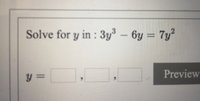You are using an out of date browser. It may not display this or other websites correctly.
You should upgrade or use an alternative browser.
You should upgrade or use an alternative browser.
Solving non-quadratic equation without a constant
- Thread starter Jameson33
- Start date
Forget factoring by grouping. It is one technique. If it doesn't work here, then think about other options. (In fact, you may find a technique that you were never taught if you think hard enough.) In this case, looking for a common factor is all you need.
[MATH]3y^3 - 6y = 7y^2 \implies y(3y^2 - 6) = y(7y).[/MATH]
Now if y is not zero, you can divide through by y and get a quadratic equation, right?
Can y = 0 be a solution?
[MATH]3(0)^3 - 6(0) = 3 * 0 - 0 = 0 - 0 = 0 = 7(0)^2.[/MATH]
So 0 is a solution. But there may be real solutions other than 0.
[MATH]y \ne 0 \text { and } y(3y^2 - 6) = y(7y) \implies 3y^2 - 6 = 7y.[/MATH]
So now what?
[MATH]3y^3 - 6y = 7y^2 \implies y(3y^2 - 6) = y(7y).[/MATH]
Now if y is not zero, you can divide through by y and get a quadratic equation, right?
Can y = 0 be a solution?
[MATH]3(0)^3 - 6(0) = 3 * 0 - 0 = 0 - 0 = 0 = 7(0)^2.[/MATH]
So 0 is a solution. But there may be real solutions other than 0.
[MATH]y \ne 0 \text { and } y(3y^2 - 6) = y(7y) \implies 3y^2 - 6 = 7y.[/MATH]
So now what?
Thank you Jeff! This led me to find 3 as a solution, along with 0. But I was unable to find the 3rd solution. Is there a better way to set up the problem to achieve an "or" chain, so you can find all 3 solutions in the same line of thinking?Forget factoring by grouping. It is one technique. If it doesn't work here, then think about other options. (In fact, you may find a technique that you were never taught if you think hard enough.) In this case, looking for a common factor is all you need.
[MATH]3y^3 - 6y = 7y^2 \implies y(3y^2 - 6) = y(7y).[/MATH]
Now if y is not zero, you can divide through by y and get a quadratic equation, right?
Can y = 0 be a solution?
[MATH]3(0)^3 - 6(0) = 3 * 0 - 0 = 0 - 0 = 0 = 7(0)^2.[/MATH]
So 0 is a solution. But there may be real solutions other than 0.
[MATH]y \ne 0 \text { and } y(3y^2 - 6) = y(7y) \implies 3y^2 - 6 = 7y.[/MATH]
So now what?
HallsofIvy
Elite Member
- Joined
- Jan 27, 2012
- Messages
- 7,763
I would have written that equation as \(\displaystyle 3y^3- 7y^2- 6y= y(3y^2- 7y- 6)= y(y- 3)(3y+ 2)= 0\) so the three solutions are y= 0, y= 3, and y= -2/3.
Yes, you can solve by factoring the original cubic as Halls did and applying the zero-product property.Thank you Jeff! This led me to find 3 as a solution, along with 0. But I was unable to find the 3rd solution. Is there a better way to set up the problem to achieve an "or" chain, so you can find all 3 solutions in the same line of thinking?
However, I know that 0 is a solution to any cubic in the form
[MATH]ax^3 + bx^2 + cx = 0[/MATH]
so I can immediately say that y = 0 is a solution to your specific problem. Moreover, if there are real solutions in addition to 0 (there may not be any), I can use the quadratic formula because
[MATH]x \ne 0 \text { and } ax^3 + bx^2 + cx = 0 \implies ax^2 + bx + c = 0.[/MATH]
So for your problem, we have
[MATH]y \ne 0 \text { and } 3y^3 -6y = 7y^ \implies 3y^2 - 6 = 7y \implies 3y^2 - 7y - 6 = 0 \implies [/MATH]
[MATH]y = \dfrac{7 \pm \sqrt{7^2 - 4(3)(-6)}}{2(3)} = \dfrac{7 \pm \sqrt{49 + 72}}{6} = \dfrac{7 \pm \sqrt{121}}{6} \implies[/MATH]
[MATH]y = \dfrac{7 + 11}{6} = 3 \text { or } y = \dfrac{7 - 11}{6} = -\ \dfrac{2}{3}.[/MATH]
So there are thre solutions, 0, 3, and -2/3.
Complete factoring or reduction to a lower degree are basic ideas in solving polynomial equations.
The important thing to learn from this problem is that there are frequently several ways to solve something. If one method does not work, try another. When I see a quadratic, I use the quadratic formula right away. Others like to try factoring first. Do what works for you.

